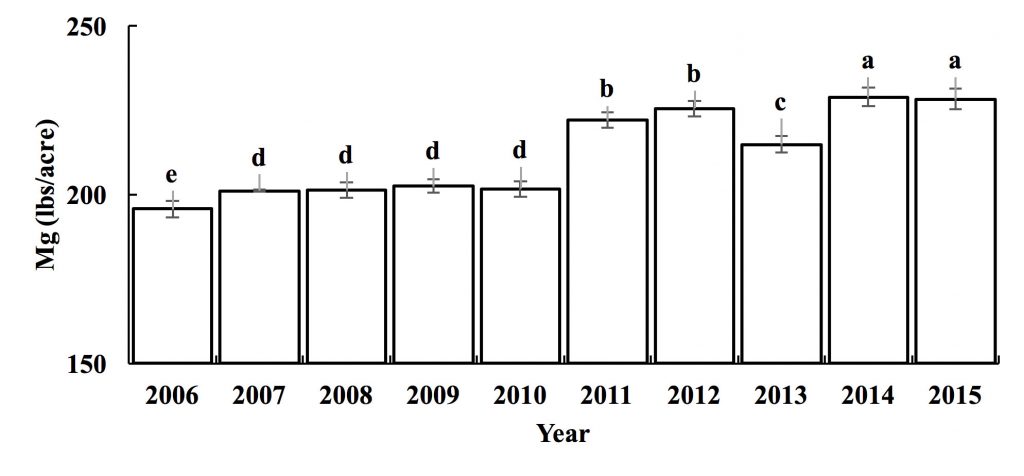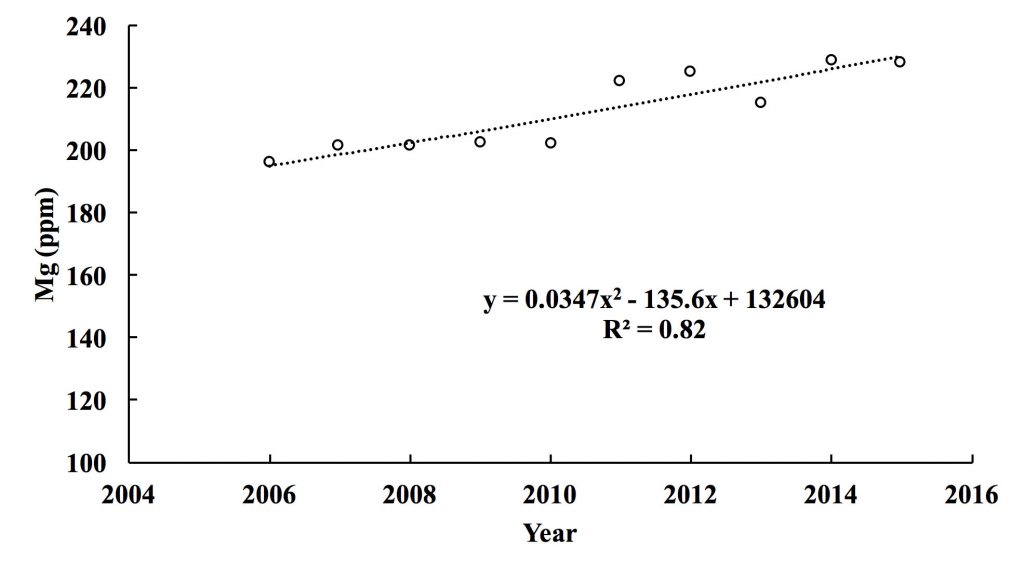Bulletin #1084, Change in Levels of Soil Potassium and Magnesium Over Time in Aroostook County, Maine: What Potato Farmers Need to Know
Developed by Lakesh Sharma, University of Maine Cooperative Extension Assistant Professor of Sustainable Agriculture, and Sukhwinder Bali, Assistant Professor of Sustainable Agriculture, University of Maine Cooperative Extension
For information about UMaine Extension programs and resources, visit extension.umaine.edu.
Find more of our publications and books at extension.umaine.edu/publications/.
Why soil potassium (K) and magnesium (Mg) levels matter to Aroostook County potato farmers
K in the soil helps to promote root growth, maintain turgor pressure, and ward off crop diseases, while Mg in soil helps to promote plant growth. Oversaturation of K in soil from supplemental application results in the loss of K into local water systems. A deficiency in soil K leads to the decay of plant tissues.
Importance of potato crop in Maine
Potatoes are Maine’s most valuable agricultural commodity, worth almost $174 million per year. About 47,000 acres of potatoes are grown in Maine, 90% of which are grown in Aroostook County.1
What was done
UMaine Extension analyzed data from soils sampled from Aroostook County between 2006 and 2015 to determine the levels of K and Mg in the rooting zone. Each year, mostly in spring and autumn, farmers and home gardeners send soil samples to the Analytical Lab and Maine Soil Testing Service. The lab processes an average of ~1,100 potato soil samples yearly. The lab provides chemical analysis and fertilizer recommendations relevant to the intended crop. The majority of samples tested from Aroostook County during this period were intended to grow potatoes.
Recommended soil K and Mg levels for potatoes
The optimum level of soil K recommended for potatoes is 3–5% of saturation levels. If K levels are too low, crops will begin to exhibit signs of deterioration, starting with the decay of their outermost leaves. Potassium heavily impacts potato quality. Small increases in soil K have been shown to lead toward high-efficiency crop removal. K tends to leach or move down through the soil with water. Because Maine’s soils tend to be gravelly, K may easily leach down to the lower soil profile. The optimum range of Mg recommended by UMaine soil lab is 10–25% saturation levels.
How farmers affect soil K and Mg
Growers apply on average 190–250 pounds/acre of K, but during successive crop rotations, they apply less or no K, which means that after about one season K tends to be at a sufficient range in Maine potato soils. Most farmers use a fertilizer blend that contains Mg, so its level in the soil increases. Mg is required in very small amounts for potatoes.
Soil K and Mg levels in Aroostook County potato fields2
Soil K was found to be increasing over the sample period, except for the first few years in this study, but the increase was not statistically significant (Figures 1 and 2). However, in potato years over the study period, a statistically significant increase in K was found (R2 = 0.45) (data not shown).

The soil K increase may be due to leftover K after grains (barley and oats) because grains are not high K-removal crops. Rainfall data3 support this reasoning. In Maine, intense rainfall tends to happen in early spring and after crop planting in late May to early June. This rainfall pattern might result in significant leaching of K.
Mg was found to have significant change over the years (Figures 3 and 4). Maximum Mg levels were recorded in 2014 and 2015, and the minimum Mg level was found in 2006. There was a statistically significant gradual increase in levels of Mg from 2006 to 2015 (R2 = 0.82). However, in potato years this correlation was 0.22, which may indicate that micronutrients were applied at a higher rate in potato years. This left Mg for grains, as evidenced by soil tests.


What should Aroostook County potato growers do?
Aroostook County growers should ensure that soil rooting zone K and Mg values stay in the optimum range. Excessive rain and snow may cause leaching of K into deeper soils and low soil K in the rooting zone. Therefore, we recommend that all potato growers in Aroostook County annually send rooting zone soil samples to the Analytical Lab and Maine Soil Testing Service for standard analysis.
For more information, contact:
Lakesh Sharma, Soil Specialist
Assistant Professor, Extension & Sustainable Agriculture
University of Maine Cooperative Extension, Presque Isle Office
57 Houlton Road
Presque Isle, Maine 04769
Office Phone: 207.764.3361
Fax: 207.764.3362
Cell: 207.498.0316
lakesh.sharma@maine.edu
Lakesh Sharma Staff Directory Listing
1 Data from USDA National Agricultural Statistics Service Quick Stats
2 Note that the results discussed throughout this publication are for the average of all relevant soil tests submitted. Before applying amendments to any field, you should submit a soil test to the UMaine Soil Lab and follow the recommendations based specifically on your results. This fact sheet is intended to alert potato farmers in Aroostook County, Maine, of potential nutrient issues with their soils.
3 Sharma, L., S. Bali, J. Dwyer, A. Plant, and A. Bhowmik. 2017. A Case Study of Improving Yield Prediction and Sulfur Deficiency Detection Using Optical Sensors and Relationship of Historical Potato Yield with Weather Data in Maine. Sensors 17(5): 1095. Available at http://www.mdpi.com/1424-8220/17/5/1095.
Information in this publication is provided purely for educational purposes. No responsibility is assumed for any problems associated with the use of products or services mentioned. No endorsement of products or companies is intended, nor is criticism of unnamed products or companies implied.
© 2018
Call 800.287.0274 (in Maine), or 207.581.3188, for information on publications and program offerings from University of Maine Cooperative Extension, or visit extension.umaine.edu.
In complying with the letter and spirit of applicable laws and pursuing its own goals of diversity, the University of Maine System does not discriminate on the grounds of race, color, religion, sex, sexual orientation, transgender status, gender, gender identity or expression, ethnicity, national origin, citizenship status, familial status, ancestry, age, disability physical or mental, genetic information, or veterans or military status in employment, education, and all other programs and activities. The University provides reasonable accommodations to qualified individuals with disabilities upon request. The following person has been designated to handle inquiries regarding non-discrimination policies: Director of Institutional Equity and Title IX Services, 5713 Chadbourne Hall, Room 412, University of Maine, Orono, ME 04469-5713, 207.581.1226, TTY 711 (Maine Relay System).


